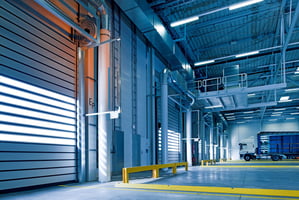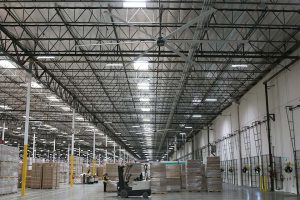According to OSHA, the ideal temperature in a workplace is between 68-76° F. If it is cooler than...
Passive Heating: Bringing Warmth to Your Facility With HVLS Fans
As climate control technology continues to advance, those responsible for the design and operation of these systems must keep them as environmentally friendly as possible. Energy efficient cooling and heating systems not only conserve natural resources, but also minimize monthly utility costs for warehouses, distribution centers, and other commercial buildings.
Passive heating is a process that uses sunlight to warm up a building. Rays of sunlight that beam down on a roof can be transferred into solar energy, which is then converted into warm air and circulated throughout a space for heat. Used properly, HVLS fans can be a critical component in a passive heating setup.
How Passive Heating Works
According to the National Institute of Building Sciences, solar heating strategies work best in small post exchange facilities (less than 10,000 square feet), warehouses, and maintenance facilities. The basic process of passive heating is as follows:
1. During the day, the sun consistently beats down on a building.
2. Solar energy from the sun is collected through windows and in parts of a building called “thermal mass.” Thermal mass is defined as materials in the building that tend to collect heat, like concrete, brick, etc.
3. The collected solar energy is distributed back down into space through convection.
According to the Whole Building Design Guide, even a modest amount of passive solar heating can reduce auxiliary heating requirements by as much as 25%. Because of their ability to distribute a large amount of air, HVLS fans can be very effective in the third step of the passive heating process.
HVLS Fans Spread Solar Warmth in a Facility
One of the challenges of passive heating is circulating warm air effectively. Since warm air is not as dense as cooler air, it tends to rise up and stay at the ceiling on top of cold air closer to ground level. This effect, known as heat stratification, explains why buildings with lots of heat from solar energy or conventional HVAC systems (or both) sometimes still feel cold.
HVLS fans can counteract stratification and distribute heat by running in reverse. Instead of pushing air downwards as the fan normally would, an HVLS fan running in reverse pulls cold air up, which displaces warm air and sends it down to the building’s ground level. This is especially important in facilities that use passive heating since much of the solar energy that enters a building comes in through the ceiling. If there is no method of distributing the energy down to the rest of the space, passive heating won’t be as effective.
Conclusion
With the right building design and materials, you don’t need to crank your heat up to high levels to keep a building warm. Passive heating takes advantage of natural solar energy that enters your space. To maximize the success of your passive heating, consult with a solar specialist and choose a method of air distribution that can efficiently send warm air from your building’s ceiling down to the ground.

